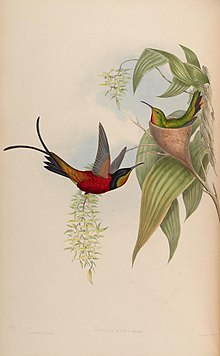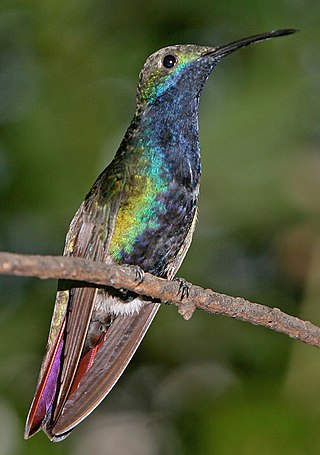
The black-throated mango is a species in subfamily Polytminae of the hummingbird family Trochilidae. It is found in Panama, in every mainland South American country except Chile, and in Trinidad and Tobago.
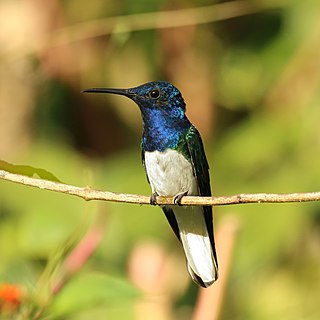
The white-necked jacobin is a medium-size hummingbird that ranges from Mexico south through Central America and northern South America into Brazil, Peru and Bolivia. It is also found in Trinidad & Tobago.

The blue-tailed emerald is a hummingbird in the "emeralds", tribe Trochilini of subfamily Trochilinae. It is found in tropical and subtropical South America east of the Andes from Colombia east to the Guianas and Trinidad, and south to northern Bolivia and central Brazil.

The hermits are tropical and subtropical hummingbirds in the subfamily Phaethornithinae, comprising 37 species in six genera. They occur from southern Mexico, through Central America, to South America as far south as northern Argentina.

Phaethornis is a genus of hummingbirds in the hermit subfamily, Phaethornithinae. They occur from southern Mexico, through Central America, to South America as far south as northern Argentina.

The collared inca is a species of hummingbird found in humid Andean forests from western Venezuela through Colombia and Ecuador to Peru. It is very distinctive in having a white chest-patch and white on the tail. Like other hummingbirds it takes energy from flower nectar, while the plant benefits from the symbiotic relationship by being pollinated. Its protein source is small arthropods such as insects. It is normally solitary and can be found at varying heights above the ground, often in the open.

Trochilinae is one of the six subfamilies that make up the hummingbird family Trochilidae.
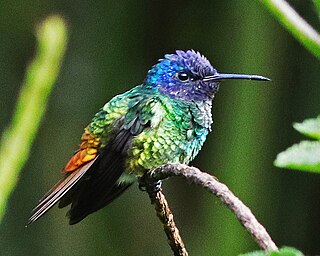
The golden-tailed sapphire is a species of hummingbird in the family Trochilidae. It is found in Bolivia, Brazil, Colombia, Ecuador, Peru, and Venezuela.

Gould's jewelfront or Gould's brilliant is a medium-sized hummingbird in the family Trochilidae. It is found in tropical and equatorial South America. This is an uncommon species with an unusually large range compared to the other members of Heliodoxa.
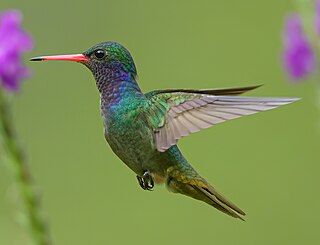
The blue-throated goldentail, also known as the blue-throated sapphire, is a species of hummingbird in the family Trochilidae. It is found in Belize, Colombia, Costa Rica, El Salvador, Guatemala, Honduras, Mexico, Nicaragua, and Panama. Its natural habitats are subtropical or tropical moist lowland forest and heavily degraded former forest.

The violet-headed hummingbird is a species of hummingbird in the family Trochilidae. It is the only species in the genus Klais.

The Tumbes hummingbird is a species of hummingbird in the "emeralds", tribe Trochilini of subfamily Trochilinae. It is found in Ecuador and Peru.
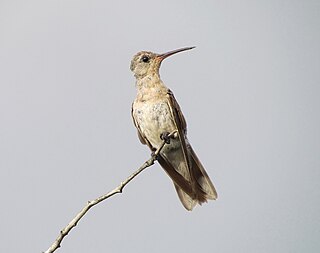
The buffy hummingbird is a species of bird in the hummingbird family Trochilidae. It is the only species placed in the genus Leucippus. This bird lives in dry forest and scrubland in northern South America where it feeds on insects and the nectar, flesh, and juice of cactus fruits.
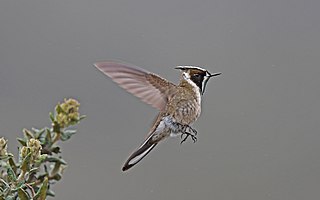
The bearded helmetcrests (Oxypogon) are a genus of hummingbird in the family Trochilidae. They are found in Colombia and Venezuela. Primary natural habitat is subtropical or tropical high-altitude grassland, known as páramo. The genus contains four species.

The crimson topaz is a species of hummingbird in the family Trochilidae. It is found in Brazil, French Guiana, Guyana, Suriname, and Venezuela.

The topazes are two species of hummingbirds in the genus Topaza. They are found in humid forests in the Amazon Basin. Males are by far the largest hummingbirds in their range – the giant hummingbird of the Andes is the only larger species in the family. Males have a total length of about 22 cm, although this includes their elongated rectrices. They are colourful, being mainly strongly iridescent golden and crimson with a black hood and a green throat. Females lack the elongated rectrices and have a mainly green plumage.

The blue-black grosbeak is a species of songbird in the family Cardinalidae.
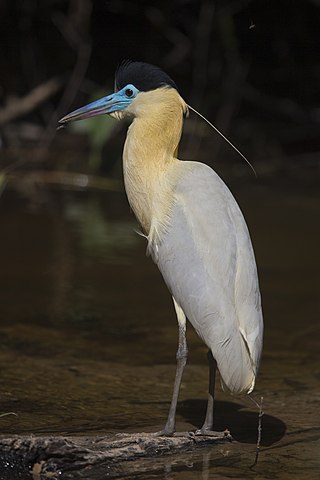
The capped heron is a water bird endemic to the neotropics, inhabiting rainforest from the center of Panama to the south of Brazil. It is the only species of the genus Pilherodius, and one of the least known of the heron family, Ardeidae. It is superficially similar to the group of the night herons, but is active during daytime or at twilight.
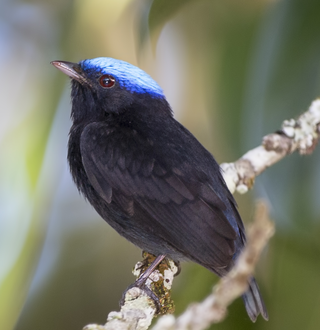
The blue-capped manakin is a species of bird in the family Pipridae. The males have a brilliant blue cap; some have black, others have green body plumage, but the relationship between the subspecies is not well understood.

Florisuginae is one of the six subfamilies in the hummingbird family Trochilidae.




